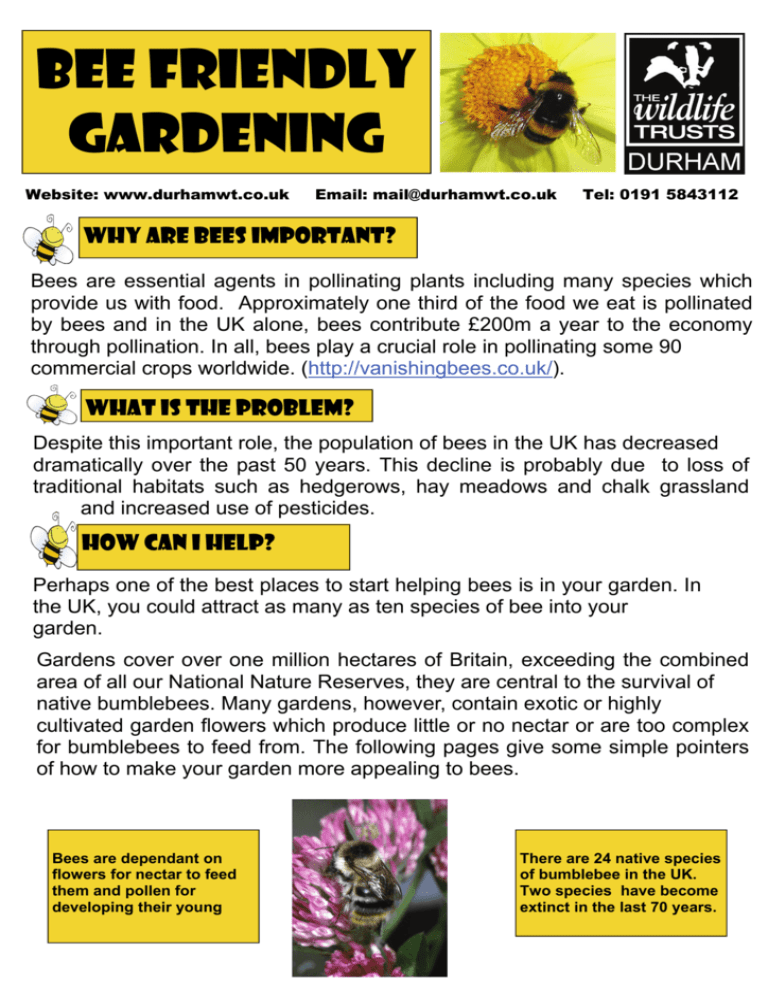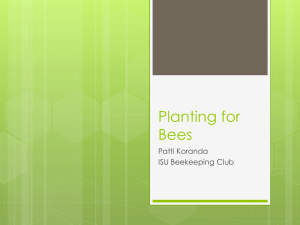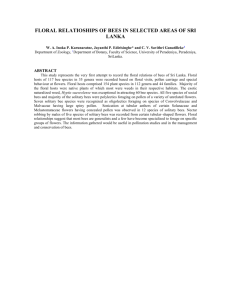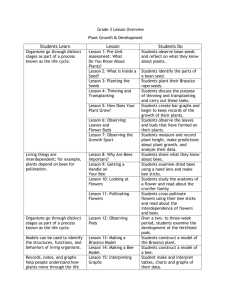Bee Friendly Gardening - Durham Wildlife Trust
advertisement

Bee Friendly Gardening Website: www.durhamwt.co.uk Email: mail@durhamwt.co.uk Tel: 0191 5843112 Why are Bees important? Bees are essential agents in pollinating plants including many species which provide us with food. Approximately one third of the food we eat is pollinated by bees and in the UK alone, bees contribute £200m a year to the economy through pollination. In all, bees play a crucial role in pollinating some 90 commercial crops worldwide. (http://vanishingbees.co.uk/). WHAT IS THE PROBLEM? Despite this important role, the population of bees in the UK has decreased dramatically over the past 50 years. This decline is probably due to loss of traditional habitats such as hedgerows, hay meadows and chalk grassland and increased use of pesticides. How can I help? Perhaps one of the best places to start helping bees is in your garden. In the UK, you could attract as many as ten species of bee into your garden. Gardens cover over one million hectares of Britain, exceeding the combined area of all our National Nature Reserves, they are central to the survival of native bumblebees. Many gardens, however, contain exotic or highly cultivated garden flowers which produce little or no nectar or are too complex for bumblebees to feed from. The following pages give some simple pointers of how to make your garden more appealing to bees. Bees are dependant on flowers for nectar to feed them and pollen for developing their young There are 24 native species of bumblebee in the UK. Two species have become extinct in the last 70 years. Gardening tips Bees feed on nectar from plants and require a food source from early Spring through to Autumn. Include a variety of early and late flowering plants in your garden to ensure they have a continual supply of food. Plant nectar flowers in dense drifts of the same species so bees can easily recognise them and save wasting energy trying to find the next food stop. The table below suggests some species to include in your bee friendly garden. Flowers for Bees Early flowers Bluebell Primrose Bugle Cherry, appple Single crocus Aubretia Lungwort (Pulmonaria) Flowering current Forget-me-not Pussy Willow Red dead-nettle Winter heather White dead-nettle TOP TIP Late flowers Michaelmas daisies Buddleia Escallionia Ivy Goldenrod Lavender Echinacea Sedum Red Valerian Allow an area of grass to grow dense and long for bees to shelter and build nest in. Carder bees build nests in long grass, other species prefer undisturbed compost heaps. Some favourites amongst the bumblebees Betony Bugle Buddleia Comfrey Clovers Knapweed Agastache Poached Egg PLant Thistles Verbascum Borage Rosemary Nasturium Catmint Toadflax Single Larkspurs Chives Lavender Marojam Sage Mints Viper Bugloss Figwort Snapdragon TOP TIP Different bees have different lengths of tongues so providing a variety of different flower shapes eg. Tubular, bell-shaped and bowl-shaped Flowers will encourage a variety of different bees. Mystery holes in your flowers? Buff-tail bumblebees have relatively small tongues which prevent them reaching the nectar of many pendulous or tubular flowers so they nibble a hole in the base of the flowers and sip the nectar out that way. Other bees and insects might use the hole afterwards. weeds We often distinguish between plants we choose to put in our gardens and ones which appear on their own—referred to as weeds. Whilst it may be in our intentions to remove such plants, TIP species such as dandelions and white clover provide a TOP Provide water for bees to good source of pollen and nectar. drink. This could be Reduce the use of pesticides Reducing the use of pesticides in the garden will benefit many species of wildlife including bees. These are some alternative methods to using pesticides. Hand Picking - Removing areas of infestation by hand might be time consuming but can be very effective and beneficial. Natural Predators - Common garden pests such as aphids and slugs can be controlled naturally by encouraging ladybirds, lacewings, frogs, hedgehogs and birds into the garden. Companion Planting - Some plants can be grown amongst fruit and vegetables to help keep pests away eg. French marigolds planted among tomatoes—the smell of the marigolds keep black and green fly away. TOP TIP Barriers - There are lots of barriers you can try around vulnerable plants, for example, sharp eggshells, copper, plastic bottles and straw around plants can all help keep the slugs at bay. Further Information something as simple as a small saucer of water with pebbles on it to allow bees to climb in and out easily. The Co-operative Vanishing of the bees project: http:// vanishing bees.co.uk Bumble Bee Conservation Trust: http://www.bumble beeconservation.org.uk/ Full list of bee attractive plants: http://nature.berkeley. edu/urbanbeegardens/docs/FullPlantList.pdf Install a bee box into your garden, or make one using bamboo canes and old teasel stems, creating hollow tubes for bees to shelter in and for solitary bees to lay their eggs. Rainton Meadows Houghton-Le-Spring Tyne & Wear DH4 6PU Tel: 0191 5843112 www.durhamwt.co.uk







